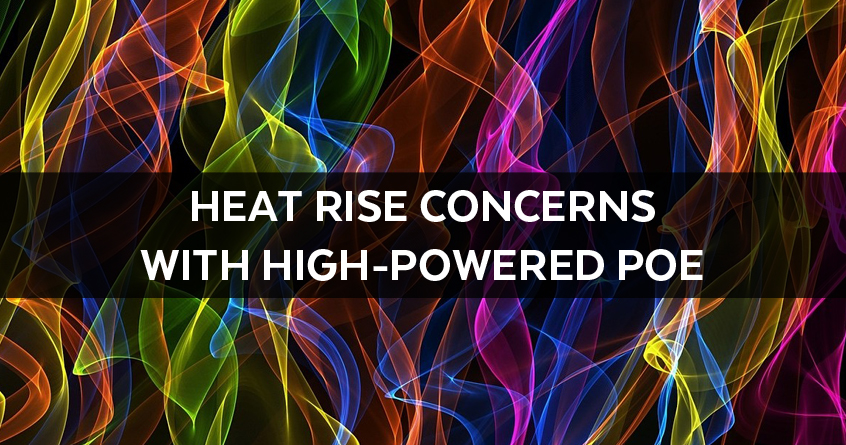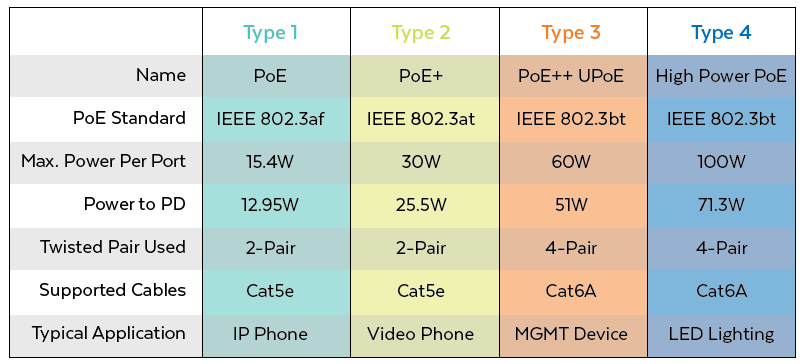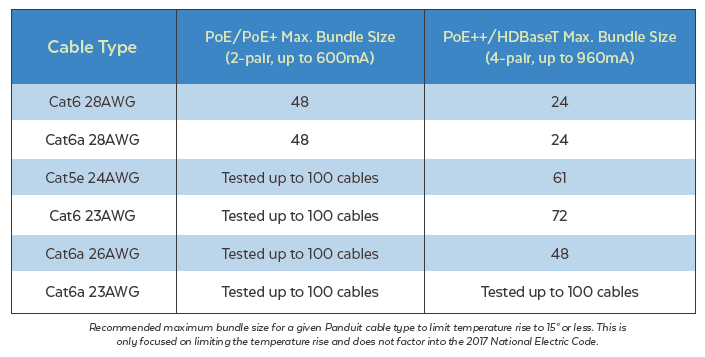Power over Ethernet (PoE) technology delivers both power and data transmission over a single copper Ethernet cable. PoE has evolved extensively since the first iteration was ratified in 2003. PoE applications extend from VoIP phones and security cameras to IoT medical devices, access control systems for intelligent buildings, and more. As every evolution of PoE has increased power, heat rise has become an important issue. This article will discuss the rise in heat with the newest generation of PoE (high-power PoE) and explore ways to avoid overheating problems.
Common Types of High-Power PoE Applications That Could Bring About Heat Rise Concerns
The high-power standard (IEEE 802.3bt) has been ratified since 2018. This generation of PoE has opened new markets and widened the scope of PoE technology. Current applications for high-power PoE include:
- Intelligent buildings with enterprise IoT (connected LED lighting)
- Safe cities (high definition pan-tilt-zoom security cameras)
- Retail POS systems and digital signage
- High-performance wireless access points
- Kiosks
- Small cells
The Current PoE Standards
Per the chart above, high-power PoE (Type 4) provides up to 100 W of DC power from the source and up to 71.3 W to each device. Simply put, more power means more heat. And the truth is that it is quite possible to have heating issues when powering PoE devices.
With Poe (802.3af) and PoE+ (802.3at), the maximum amount of power to the power source equipment (PSE) is 15.4 W and 30 W, respectively. At this level, where two pairs are enough to carry the current, there is a low expectation of overheating unless there are extreme ambient temperatures or the cable bundles are too large.
The PoE++ and high-power PoE (802.3bt) standards are deployed when more power is needed. As these Type 3 and Type 4 standards use all four pairs, the amount of power is doubled. However, higher power is not the only concern here; “heat rise” becomes an issue.
Heat Rise and High-Power PoE
Heat rise can have these adverse effects on PoE devices:
- Increase in insertion loss: Insertion loss is the ratio of the received signal to the amount of inserted signal power at the end of a cable. It describes the signal’s strength (or loss) at any point on a cable and is commonly known as cable attenuation. The cable length may need to be shortened to maintain good signal quality.
- Weak signal strength
- Premature aging or damage to the cable jacket
- Reduction of transmission length
Ways to Minimize Heat Rise in PoE Devices
1. Choose High-Category PoE Cables
Rule of Thumb: The higher the cable category, the lower the heat rise. The Telecommunications Association (TIA) suggests that all new PoE installations use Cat6A Ethernet cabling.
2. Choose Cabling with a Larger Conductor
Conductor resistance is a prime cause of heat-rise issues in PoE applications. Larger conductors allow for easier current flow reducing conductor resistance, which in turn reduces heat. It is important to note that the larger the conductor is, the lower its gauge number will be. Cat6 or Cat6A Ethernet cables generate 80 percent less conductor resistance and are a preferred choice for heat reduction.
3. Choose Conductors with Solid Metal Bodies
Thermoplastic cable jacketing is subject to softening and distorting when exposed to heat. In contrast, all-metal-body construction allows for higher conductivity and heat dissipation; therefore, it is preferred.
4. Choose Shielded Cabling
Metallic shields or foil are known for dissipating heat. Therefore, using S/FTP (shielded with foiled twisted pairs) or S/UTP (shielded with unshielded twisted pairs) cables are best for high-power PoE applications.
5. Use a Smaller Bundle Size
In testing done by the TIA they concluded that the larger the cable bundle, the higher its core temperature will be. Therefore, their TSB-184-A cabling standard (“Guidelines for Supporting Power Delivery Over Balanced Twisted-Pair Cabling”) recommends leaving cables unbundled to ensure better heat dissipation. However, if this is not possible, smaller bundles are suggested.
6. Have a Cable Management Plan
It is wise to group cables loosely instead of bundling them tightly together. Cables or cable bundles should be dispersed as loosely as possible around the area. It is essential to recognize that high cable density contributes to more heat within the cables or cable bundles. The use of cable management tools will assist in ensuring better cable airflow.
A Few Points Regarding PoE Cabling and Heat Rise Issues
- PoE technology uses a constant power delivery model, which inherently has a lower heat rise risk.
- When unsure of a PoE system’s potential for heat rise, the simplest solution is to reduce the number of cables in each bundle.
- When installing PoE cables, always consider bundle size, environmental temperatures, and power levels.
- The use of cables in open tray tables reduces heat rise significantly.
- To ensure the best PoE performance, the heat rise should be less than 45 degrees C.
- Use TIA-568-C.2-compliant patch cords as non-compliant patch cords will ultimately fail when used in PoE applications.
Last Words
Planet Technology USA is a U.S.-based distributor of Planet Technology, Inc. We work directly with Planet Technology in Taiwan to provide the best quality service and latest solutions for our customers.
For further reading:
How to Choose the Best PoE Ethernet Cables and Cable Type for Your Project


